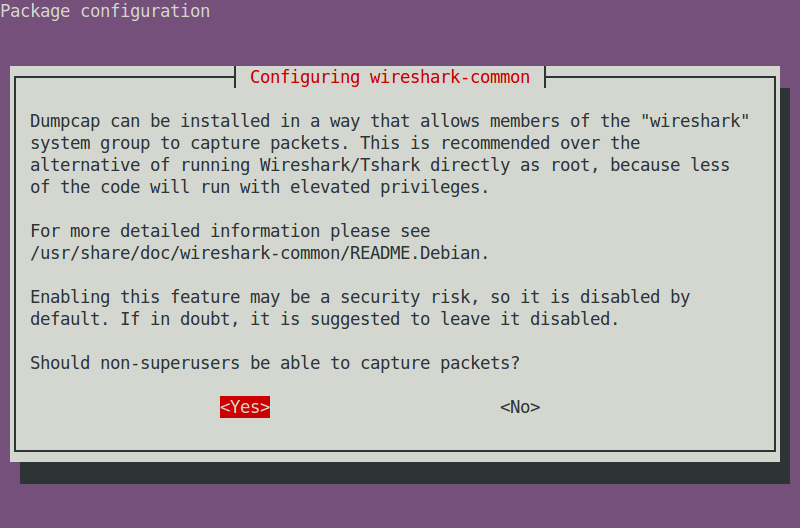
loopback) or just tick the Enable promiscuous mode on all interfaces option and press the Start button. In order to start your first capture, select Capture in top menu, then pick one interface (e.g. Then log out and in again a you are ready to go! All you need to do is to add your user account into the group like this, substituting your username for username: $ sudo usermod -a -G wireshark username Users in this group can capture network traffic. Setting permissionsĭuring installation, a system group called wireshark was created. Therefore, we will set up permissions for regular users to capture on network interfaces (see below about security implications). At this point, you can use Wireshark as root, but it is generally considered a bad practice.

Install wireshark linux command line install#
This will install both Qt and the CLI version of Wireshark.

In order to install the Wireshark GUI from repositories, simply type… $ sudo dnf install wireshark-qt Nevertheless the old GUI is still available and you can choose which one you want to use. You can use it either for real-time network analysis or to inspect files with captured traffic such as pcap files.įor many years, the primary framework for the graphical user interface (GUI) used to be GTK, but since version 2.0, Qt became the framework of a choice. It offers both terminal and graphical user interfaces and both are available on Fedora.

Let us know if you faced any challenges during installation and we'll help you fix them.Wireshark is popular tool for network protocol analysis used by education institutions and in the industry.
Install wireshark linux command line how to#
We also learned how to compile from source for any Linux distro. In this article, we learned to install wireshark on Ubuntu, CentOS and Arch Linux. If you are getting a ‘Permission Denied’ error when running wireshark as local user, you can start the it with root privileges or add the user account to wireshark group using the following command: $ sudo usermod -a -G wireshark username The -w flag is used to specify a file where the captured traffic will be saved for later processing. Change 'eth0' to whatever your interface name is. The -i flag is used to specify the interface from which we expect to see the RADIUS packets. In this example, only IP packets that are coming from or going to UDP port 1812 are captured. Packets that do not verify the condition following the -f flag will not be captured. The -f flag is used to specify a network capture filter (more on filters later). If you want to capture the packets coming from/going to UDP port 1812 on eth0, you can use tshark command as follows: $ tshark -f "tcp port 80" -i eth0 -w capture.cap On Ubuntu, you can install it with the command: $ sudo apt install tshark Using Tshark Tshark is automatically on CentOS 7 when you install wireshark. It will use the pcap library to capture traffic from the first available network interface and displays a summary line on stdout for each received packet. TShark is a command line tool that comes along with Wireshark to capture live traffic as well as read and parse capture files. Without any options set, TShark will work much like tcpdump. Installing from source will require you to compile the source code. Once the requirements are met, run the following commands in the terminal to install the source code. Or if you prefer the GTK+ interface, use this command: $ sudo pacman -S wireshark-gtk Installing from Source In the terminal, type the following commands: $ sudo pacman -S wireshark-qt Launch it from the launcher or type the following command in the command line: $ wireshark Installing on Arch Linux $ sudo yum install wireshark wireshark-qt wireshark-gnome In the terminal, type the following commands: $ yum install gcc gcc-c++ bison flex libpcap-devel qt-devel gtk3-devel rpm-build libtool c-ares-devel qt5-qtbase-devel qt5-qtmultimedia-devel qt5-linguist desktop-file-utils We will install Wireshark on CentOS 7 using yum.

You can launch it from dash or type the command: $ wireshark Installing on CentOS 7 Press the left arrow key on your keyboard to select and hit Enter. $ sudo add-apt-repository ppa:wireshark-dev/stableĭuring the installation, if you're asked if non-superusers be able to capture packets. Once all the dependencies have been installed, we run the following in the terminal. Before we begin installation, let's meet the dependencies: $ sudo apt-get install build-essential checkinstall libcurl4-openssl-dev bison flex qt5-default qttools5-dev libssl-dev libgtk-3-dev libpcap-d


 0 kommentar(er)
0 kommentar(er)
